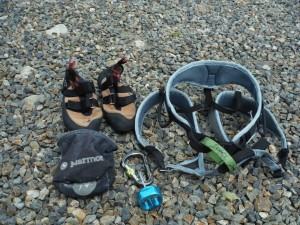I get asked all the time on courses “What do I need to start Climbing on my own?”. The biggest thing you need is the basic skills to put a harness on, tie in to a rope, and belay safely. Once you can do all that, and are sure climbing is for you, there really isn’t that much kit you need to start out indoor climbing….
So, once you can correctly answer the usual “tick Yes or No” questions a wall might ask you on their disclaimer forms, lets get shopping! Below is a picture of all the kit you need to start climbing indoors, bottom-roping, using the “in-situ” ropes at the climbing centre:
Harness – There are a plethora of different types out there, Men’s/Women’s, “zip-lock buckles”/double back through buckles, fully adjustable/fixed leg loops etc.. etc… The 2 most important things to consider are – 1. Is it the right size? and 2. Is it comfy? If these 2 boxes are ticked, then you’ll be alright, by the time you want to do more adventurous climbing and perhaps need a different harness, it’ll be time to get a new one anyway. All the manufacturers have to pass the same safety standards, but there can be a difference in quality, so don’t necessarily go for the cheapest one.. Spend some time in a shop trying a few on, have a hang in them (most good shops will have a hang point) to get a feel of how comfy they are. Always follow the manufactures recommendations with care, maintenance and retiring kit…
Shoes – The same goes for shoes, with a dazzling array out there for you to choose from. Ideally we want a tight pair, with our toes right up in the end of the shoe, but in a way that is comfortable to wear for prolonged periods. The shoe should not hurt! Our feet are complicated, delicate things, so don’t ram them into tight shoes… Top tip – cut your toe nails regularly! Avoid a really technical pair for your first shoe, try loads on as they are all different shapes and sizes, and when you feel your climbing is coming on enough to warrant a more technical pair, then I’m sure you’ll have worn out your first pair and will be needing a new pair anyway!
Belay Device/Carabiner – You’re best of getting a nice simple belay plate type device, such as the brilliant DMM Bug (pictured), and an HMS (often called Pear Shaped) Carabiner to accompany it. There are lots of different fancy devices out there, which are great for certain jobs, but perhaps not all – we’ll look at these in another article. So for now, nice and simple, and these are the best all round devices. All the usual manufactures produce them, they will all work! Watch you don’t accidentally get a specialist one that’s designed for thinner ropes – you wont be using those indoors where the ropes will be 10mm+.
Some Carabiners can come with the addition of a plate or clip that stop them swivelling round on your harness (e.g. – DMM Belay Master) and these are great for preventing cross loading (Come on a course with us to learn what that means!), but if you learn to belay really well and are vigilant, then I’d go without them. Belaying as a skill is easily done wrong, to learn it well is an art, and a life-saver.
Chalk-Bag – To stop your sweaty hands slipping off! Whatever you like the look of. Get a chalk-bag belt or a piece of cord to tie it around your waist. It’s useful to use a chalk ball with a small amount of loose chalk powder, if you’re somewhere really warm liquid chalk is great, especially for sport climbing and DWS… NEVER clip it on to your harness with a carabiner – this puts a big hard metal object at the bottom of your spine, and there have been cases of people being paralysed after falling off and landing on it…
Next we’ll look at the additional kit to go Sport Climbing outdoors….
If you’re looking to buy any kit, if you’ve attended one of our courses we can offer you a 15% discount at the excellent V12 in Llanberis – one of the best climbing shops around.



